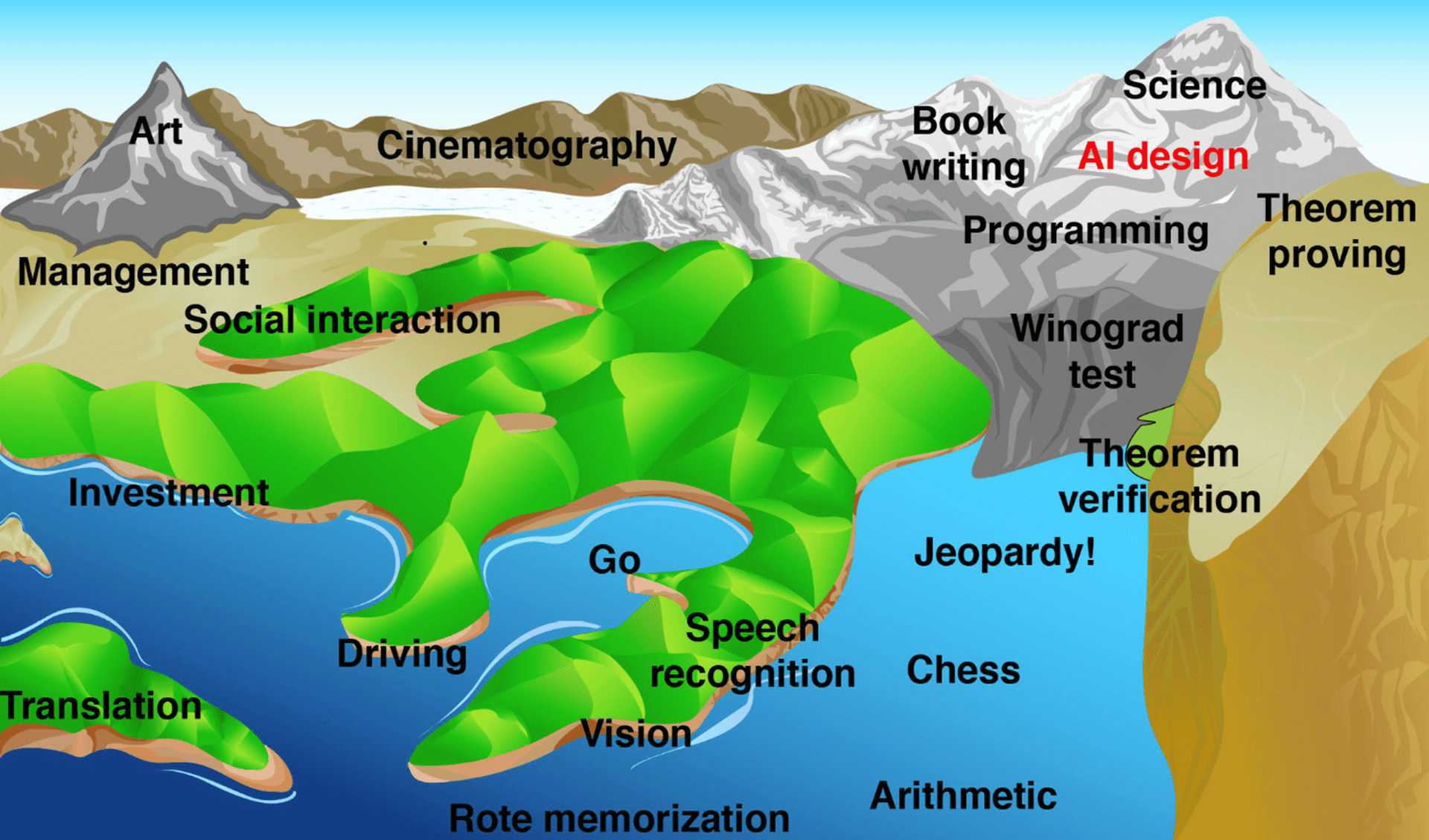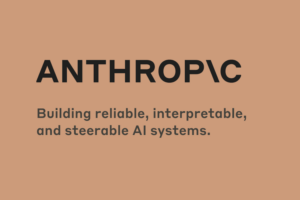Download image: 1920 res, full res (4MB).
1997
In 1997, Roboticist and futurist Hans Moravec wrote the following metaphor:
The Great Flood
Computers are universal machines, their potential extends uniformly over a boundless expanse of tasks. Human potentials, on the other hand, are strong in areas long important for survival, but weak in things far removed. Imagine a “landscape of human competence,” having lowlands with labels like “arithmetic” and “rote memorization”, foothills like “theorem proving” and “chess playing,” and high mountain peaks labeled “locomotion,” “hand-eye coordination” and “social interaction.” We all live in the solid mountaintops, but it takes great effort to reach the rest of the terrain, and only a few of us work each patch.Advancing computer performance is like water slowly flooding the landscape. A half century ago it began to drown the lowlands, driving out human calculators and record clerks, but leaving most of us dry. Now the flood has reached the foothills, and our outposts there are contemplating retreat. We feel safe on our peaks, but, at the present rate, those too will be submerged within another half century. I propose (Moravec 1998) that we build Arks as that day nears, and adopt a seafaring life! For now, though, we must rely on our representatives in the lowlands to tell us what water is really like.
Our representatives on the foothills of chess and theorem-proving report signs of intelligence. Why didn’t we get similar reports decades before, from the lowlands, as computers surpassed humans in arithmetic and rote memorization? Actually, we did, at the time. Computers that calculated like thousands of mathematicians were hailed as “giant brains,” and inspired the first generation of AI research. After all, the machines were doing something beyond any animal, that needed human intelligence, concentration and years of training. But it is hard to recapture that magic now. One reason is that computers’ demonstrated stupidity in other areas biases our judgment. Another relates to our own ineptitude. We do arithmetic or keep records so painstakingly and externally, that the small mechanical steps in a long calculation are obvious, while the big picture often escapes us. Like Deep Blue’s builders, we see the process too much from the inside to appreciate the subtlety that it may have on the outside. But there is a non-obviousness in snowstorms or tornadoes that emerge from the repetitive arithmetic of weather simulations, or in rippling tyrannosaur skin from movie animation calculations. We rarely call it intelligence, but “artificial reality” may be an even more profound concept than artificial intelligence.
The mental steps underlying good human chess playing and theorem proving are complex and hidden, putting a mechanical interpretation out of reach. Those who can follow the play naturally describe it instead in mentalistic language, using terms like strategy, understanding and creativity. When a machine manages to be simultaneously meaningful and surprising in the same rich way, it too compels a mentalistic interpretation. Of course, somewhere behind the scenes, there are programmers who, in principle, have a mechanical interpretation. But even for them, that interpretation loses its grip as the working program fills its memory with details too voluminous for them to grasp. As the rising flood reaches more populated heights, machines will begin to do well in areas a greater number can appreciate. The visceral sense of a thinking presence in machinery will become increasingly widespread. When the highest peaks are covered, there will be machines than can interact as intelligently as any human on any subject. The presence of minds in machines will then become self−evident. (Moravec, Dec/1997, PDF).
2017
20 years later, in 2017, Max Tegmark added:
During the decades since he wrote those passages, the sea level has kept rising relentlessly, as he predicted, like global warming on steroids, and some of his foothills (including chess) have long since been submerged. What comes next and what we should do about it is the topic of the rest of this book. As the sea level keeps rising, it may one day reach a tipping point, triggering dramatic change. This critical sea level is the one corresponding to machines becoming able to perform AI design. Before this tipping point is reached, the sea-level rise is caused by humans improving machines; afterward, the rise can be driven by machines improving machines, potentially much faster than humans could have done, rapidly submerging all land. This is the fascinating and controversial idea of the singularity…
Tegmark also penned the illustration, with the caption:
Figure 2.2: Illustration of Hans Moravec’s “landscape of human competence,” where elevation represents difficulty for computers, and the rising sea level represents what computers are able to do.
(Alan’s note: Tegmark said that ‘I love this metaphor from Hans Moravec, and have taken the liberty to illustrate it in figure 2.2.’ Did Tegmark use Microsoft Paint? Could he not have hired a professional designer?!)
2023 and AGI
More than 25 years later in 2023, we are at a point where AI is designing itself in both hardware and software.
Read more at LifeArchitect.ai/AGI.
Primary sources
1. Original text by Hans Moravec: When will computer hardware match the human brain? published in Journal of Evolution and Technology 1 (1):10 (1998) (received Dec/1997).
2. Illustration appeared in Max Tegmark’s book: Life 3.0 (Aug/2017).
3. Cited in several papers including: AI as a Threat to Democracy: Towards an Empirically Grounded Theory (Dec/2017).
Get The Memo
by Dr Alan D. Thompson · Be inside the lightning-fast AI revolution.Bestseller. 10,000+ readers from 142 countries. Microsoft, Tesla, Google...
Artificial intelligence that matters, as it happens, in plain English.
Get The Memo.
 Dr Alan D. Thompson is an AI expert and consultant, advising Fortune 500s and governments on post-2020 large language models. His work on artificial intelligence has been featured at NYU, with Microsoft AI and Google AI teams, at the University of Oxford’s 2021 debate on AI Ethics, and in the Leta AI (GPT-3) experiments viewed more than 4.5 million times. A contributor to the fields of human intelligence and peak performance, he has held positions as chairman for Mensa International, consultant to GE and Warner Bros, and memberships with the IEEE and IET. Technical highlights.
Dr Alan D. Thompson is an AI expert and consultant, advising Fortune 500s and governments on post-2020 large language models. His work on artificial intelligence has been featured at NYU, with Microsoft AI and Google AI teams, at the University of Oxford’s 2021 debate on AI Ethics, and in the Leta AI (GPT-3) experiments viewed more than 4.5 million times. A contributor to the fields of human intelligence and peak performance, he has held positions as chairman for Mensa International, consultant to GE and Warner Bros, and memberships with the IEEE and IET. Technical highlights.This page last updated: 28/Feb/2023. https://lifearchitect.ai/flood/↑






